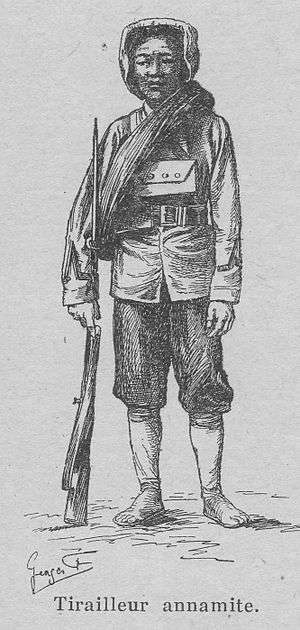Tirailleurs indochinois

The Tirailleurs indochinois (Vietnamese: Lính tập) were soldiers of several regiments of local and ethnic Indochinese infantry organized as Tirailleurs by the French colonial authorities, initially in Vietnam from 15 March 1880.[1][2] The most notable, and first established, of these units were the Tonkinese Rifles (French: Tirailleurs tonkinois, Vietnamese: Quân đoàn bộ binh Bắc Kỳ).
History
In the early days of these regiments the charge was often made that the Lính tập were prone to desertion.[3]
However under the leadership of officers seconded from the regular French Marine (subsequently Colonial) Infantry the Lính tập became an effective corps, without which the French would have had difficulty in occupying and garrisoning their Indochinese processions.
The Tirailleurs indochinois saw active service in Indochina, China (Boxer Rebellion), Russia (Allied intervention 1918–19), Syria (1920–21) and Morocco (1925–26). During World War I the French Army was initially reluctant to deploy its Indochinese troops on the Western Front but eventually 40,000 Annamite and Cambodian tirailleurs were sent to France.[4]The majority were employed behind the lines in guard, depot and factory-worker duties. However several battalions fought at Verdun, the Chemin des Dames, and in Champagne.[5]
On 10 February 1930 fifty soldiers of the Tonkinese Rifles rose in support of the VNQDD during the Yen Bai mutiny, which was quickly suppressed by loyal tirailleurs of the same regiment[6]but resulted in increased recruitment of non-Vietnamese soldiers.
In 1945 some Lính tập units fought against the Japanese occupation of Vietnam. In particular the "3e RTT" (3e régiment de tirailleurs tonkinois) offered fierce resistance but was annihilated. The six Tonkinese and Annamite tirailleur regiments then in existence were destroyed or dispersed in the course of the Japanese coup, and were not reestablished. Large numbers of Vietnamese troops did however serve in the French Union Forces during the French Indochina War (1946–1954) and the last Indochinese unit in the French Army was not disbanded until 1960.[7]
Regiments
The regiments were founded in each of the territories of Tonkin, Annam and Cambodia.
Tirailleurs tonkinois ("Tonkinese Rifles")
- 1er régiment de tirailleurs tonkinois
- 2e régiment de tirailleurs tonkinois
- 3e régiment de tirailleurs tonkinois
- 4e régiment de tirailleurs tonkinois
Tirailleurs annamites
- 1er Régiment de tirailleurs annamites
- 2e Régiment de tirailleurs annamites
- Bataillon de tirailleurs montagnards du sud Annam
Tirailleurs cambodgiens
- Bataillon de tirailleurs cambodgiens
- Régiment de tirailleurs cambodgiens
References
- ↑ Maurice Rives, Eric Deroo Les Lính tâp: Histoire des militaires indochinois au service de la France, 1859-1960
- ↑ Elisée Reclus Nouvelle géographie universelle: la terre et les hommes Volume 8 1883- "Des bataillons annamites, les linh-tap, aident à la défense de la colonie, et des volontaires se présentent en grand nombre pour la servir."
- ↑ Albert Marie Aristide Bouinais, A. Paulus - L'Indo-Chine française contemporaine: Cochinchine. Cambodge 1885- Page 190 "Le régiment des tirailleurs annamites, ou linh-tap, a été créé par décret du 15 mars 1880. L'uniforme des soldats est très bien approprié au climat: il consiste en un pantalon blanc très court, une chemise-vareuse bleue sur laquelle se boucle .." "Les tirailleurs annamites vivent en famille sous la tutelle de leur capitaine. Nous ne pouvons que louer ... Les principaux délits qu'on reproche aux linh-tap sont le vol et la désertion ; ce dernier est très fréquent."
- ↑ Jouineau, Andre. French Army 1918 1915 to Victory. p. 63. ISBN 978-2-35250-105-3.
- ↑ Jouineau, Andre. French Army 1918 1915 to Victory. p. 63. ISBN 978-2-35250-105-3.
- ↑ Maurice Rives, pages 72-73 Les Linh Tap, ISBN 2-7025-0436-1
- ↑ Maurice Rives, pages 125-127 Les Linh Tap, ISBN 2-7025-0436-1